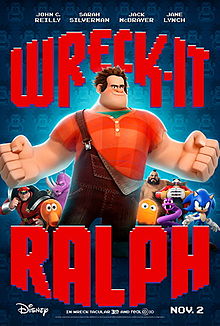
Future Fragments: Wreck-it Ralph, Disney + the Video Game Princess
Written by: Anastasia Salter, Pop-Culture Editor
 Disney’s video-game inspired Wreck-it Ralph just arrived in theatres, bringing with it a heavy dose of digital nostalgia and inevitable questions from children about arcades. The reinterpretation of Donkey Kong, Mario, Halo, and other major titles is gorgeous (and surprisingly compelling in 3D.) But in between Sonic sightings and Qbert jokes, there’s also a beautiful rejection of the princess formula that has powered so many Disney franchises and sold so many tulle gowns to the toddler set. Wreck it Ralph is perhaps the most Pixar-like film to come out of the Disney Studios so far, but it manages to sidestep much of the male-centric worldview that characterizes Pixar’s productions (with Brave a dubious exception).
Disney’s video-game inspired Wreck-it Ralph just arrived in theatres, bringing with it a heavy dose of digital nostalgia and inevitable questions from children about arcades. The reinterpretation of Donkey Kong, Mario, Halo, and other major titles is gorgeous (and surprisingly compelling in 3D.) But in between Sonic sightings and Qbert jokes, there’s also a beautiful rejection of the princess formula that has powered so many Disney franchises and sold so many tulle gowns to the toddler set. Wreck it Ralph is perhaps the most Pixar-like film to come out of the Disney Studios so far, but it manages to sidestep much of the male-centric worldview that characterizes Pixar’s productions (with Brave a dubious exception).
While filmmakers have remade several video game franchises as movies, usually to disastrous results (Doom, anyone?), there are fewer movies based on abstracted video game worlds themselves. Some of the best are films like The Last Starfighter, eXistenZ, and even Tron–films that bridge the gap between the world where the physical hardware lives and the world inside gamespace. Wreck-it Ralph is a video game movie of this latter type, although it resembles Toy Story more than any of those predecessors, most of which featured the rise of the geek hero: gamers empowered by their mastery of the medium.
Mostly, those journeys have followed male gamers and characters—unless we count Angelina Jolie’s Tomb Raider—and brought the baggage of the medium with them. Watching the previews made me deeply concerned that Wreck-it Ralph would follow in that trend, particularly as the inevitable parallels to Nintendo mount up. For all their virtues in story and world-building, Nintendo games tend to have some of the most powerless female characters. Princess Peach, doomed to be continually stranded in another tower, is practically a Disney princess already (complete with gown.)
Wreck-it Ralph follows the Donkey Kong-esque Ralph, a villain tired of endlessly breaking villains and living in the trash of his 30-year-old video game community. He travels out beyond his game and into modern video games through a grand centeral station housed in the arcade’s electrical system, offering plenty of opportunities for Disney to showcase the serious evolution of games (and 3D characther modeling) both in content and form. Toy Story imagined the emotional lives of inanimate objects, while Wreck-it Ralph works with characters whose lives are usually scripted–literally, as many of the characters are fundamentally defined by their programming. Wreck-it Ralph cannot stop breaking things any more than his compatriot Fix-it Felix can stop fixing them.
In his game-hopping quest for meaning or at least a shiny medal, Ralph encounters two women from opposite ends of the video game spectrum. The first is a hyperfeminine supersolider type Calhoun, straight out of Halo or Samus, with a tragic backstory that keeps her removed from emotional connections. The second is a anime girl with candy in her hair and a tendency towards crude humor, Vanellope, who is on her own mission to become a racer in Sugar Rush, a Mario Kart-esque racing game through a virtual Candyland, Thankfully, she’s already one to take steps towards her goal, and she’s not waiting for someone to sweep her off to a cushier life in the castle.By contrast, the biggest problem with female game characters is as they tend to be NPCs–rather than playable avatars–they’re often defined by someone else’s desire. Perhaps the best twist on that formula is in indie game Braid, which takes the “princess rescue” platformer to unexpected places.
Disney movies have about as good a track record as video games themselves when it comes to empowered female characters: the Disney princesses are generally the stars of their stories, but historically haven’t been the best at rescuing themselves. That tide is turning thanks to films like Tangled and Wreck-it Ralph. If you make it out to see Wreck-it Ralph, there’s lots to respect in the rendering of these many game worlds–and in Vanellope’s fairly progressive story arc. (Not to mention the stunning and technically innovative short film before the credits.) Given the often painful expressions of gender politics surrounding gaming culture, this is hopefully a sign that the next generation of gaming will have more female characters motivated by their own quests rather than waiting as rewards for others.
And if it isn’t a beacon for the industry, well, at least it’s another step forward for Disney, and a nice film counterpart to the playfulness and gaming popping up throughout their parks.
